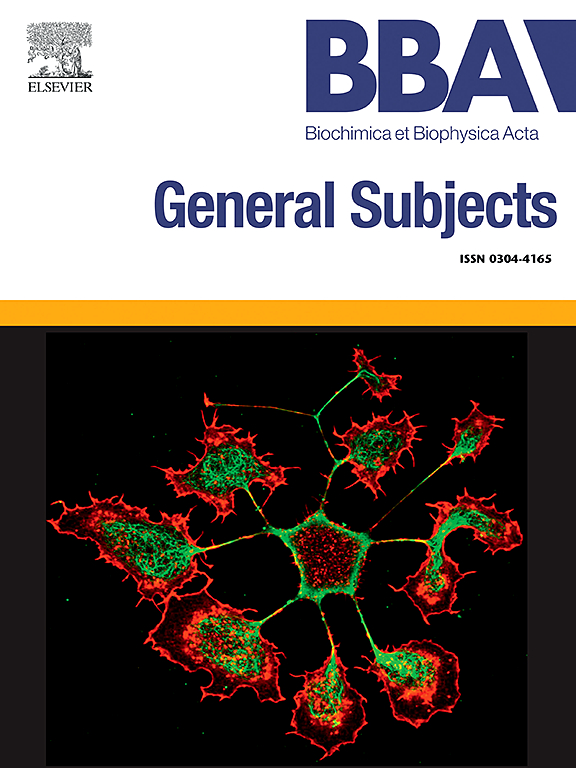Rhipicephalus microplus triosephosphate isomerase dimer interface is stabilized by a key cysteine residue
IF 2.2
3区 生物学
Q3 BIOCHEMISTRY & MOLECULAR BIOLOGY
Biochimica et biophysica acta. General subjects
Pub Date : 2025-09-12
DOI:10.1016/j.bbagen.2025.130857
引用次数: 0
Abstract
The functional significance of a non-conserved cysteine residue (C86) proximal to the interfacial region of Rhipicephalus microplus triosephosphate isomerase (RmTIM) was investigated through systematic substitution with aspartic acid (C86D), lysine (C86K), and alanine (C86A) via site-directed mutagenesis. Kinetic analyses revealed substantial perturbations in enzymatic parameters for the C86D and C86K variants, with marked alterations in maximal velocity (Vmax), substrate affinity (Km), catalytic turnover (kcat), and catalytic efficiency (kcat/Km). Thermodynamic destabilization was universally observed across all mutants via Protein Thermal Shift assays, with reductions in melting temperature (Tm) ranging from 15.7 to 27.1 °C relative to the wild-type enzyme (Wt-TIM). Chemical denaturation studies employing guanidine hydrochloride demonstrated heightened susceptibility to unfolding in all mutants, with destabilization profiles following the order: C86K > C86D > C86A. Computational structural analyses elucidated molecular mechanisms underlying these perturbations. Disruption of a putative salt bridge between residues D49 and K18 was predicted in the C86K mutant, potentially destabilizing the dimeric interface. Comparative free energy calculations (ΔG) further corroborated these findings: Wt-TIM exhibited a ΔG of −21.2 kcal/mol and an interfacial contact area of 1604.8 Å2, indicative of robust dimeric stabilization. In contrast, the C86K mutant displayed diminished stability (ΔG = −16.0 kcal/mol) despite an expanded interface (1615.6 Å2), suggesting compromised packing efficiency. These observations imply that C86, while not directly conserved, plays a critical structural role in maintaining interfacial integrity and catalytic competence. The pronounced destabilization and kinetic impairment observed in the C86K variant highlight the residue's significance in RmTIM functionality. This residue-specific destabilization strategy may aid in the rational design of acaricidal compounds targeting interfacial regions of RmTIM, taking advantage of structural vulnerabilities produced by non-conserved residues.

微头猪三磷酸异构酶二聚体界面由一个关键的半胱氨酸残基稳定。
采用定点诱变的方法,系统替换了天冬氨酸(C86D)、赖氨酸(C86K)和丙氨酸(C86A),研究了微头猪三磷酸酯异构酶(RmTIM)界面附近的非保守半胱氨酸残基(C86)的功能意义。动力学分析显示,C86D和C86K变体的酶促参数发生了实质性的扰动,最大速度(Vmax)、底物亲和力(Km)、催化周转率(kcat)和催化效率(kcat/Km)发生了显著变化。通过蛋白质热移分析,所有突变体都普遍观察到热力学不稳定,相对于野生型酶(Wt-TIM),熔化温度(Tm)降低了15.7至27.1 °C。使用盐酸胍的化学变性研究表明,所有突变体对展开的敏感性都提高了,不稳定谱的顺序如下:C86K > C86D > C86A。计算结构分析阐明了这些扰动背后的分子机制。在C86K突变体中,预测残基D49和K18之间假定的盐桥断裂,可能破坏二聚体界面的稳定。比较自由能计算(ΔG)进一步证实了这些发现:Wt-TIM表现出-21.2 kcal/mol的ΔG和1604.8 Å2的界面接触面积,表明二聚体稳定。相比之下,C86K突变体表现出稳定性降低(ΔG = -16.0 kcal/mol),尽管扩大了界面(1615.6 Å2),表明包装效率降低。这些观察结果表明,C86虽然不是直接保守的,但在维持界面完整性和催化能力方面起着关键的结构作用。在C86K变体中观察到的明显的不稳定和动力学损伤突出了残基在RmTIM功能中的重要性。这种残基特异性不稳定策略可能有助于合理设计针对RmTIM界面区域的杀螨化合物,利用非保守残基产生的结构脆弱性。
本文章由计算机程序翻译,如有差异,请以英文原文为准。
求助全文
约1分钟内获得全文
求助全文
来源期刊

Biochimica et biophysica acta. General subjects
生物-生化与分子生物学
CiteScore
6.40
自引率
0.00%
发文量
139
审稿时长
30 days
期刊介绍:
BBA General Subjects accepts for submission either original, hypothesis-driven studies or reviews covering subjects in biochemistry and biophysics that are considered to have general interest for a wide audience. Manuscripts with interdisciplinary approaches are especially encouraged.
 求助内容:
求助内容: 应助结果提醒方式:
应助结果提醒方式:


